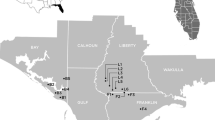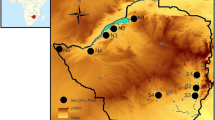Abstract
Castilleja levisecta (Scrophulariaceae), the golden paintbrush, is an insect-pollinated herbaceaous perennial found in the Pacific Northwest. Currently restricted to two island populations off British Columbia and nine populations (eight on islands) in Washington, C. levisecta is a rare species threatened with extinction. Allozymes were used to describe genetic diversity and structure in these eleven populations. Despite its threatened status and small geographic range, exceptionally high levels of genetic diversity are maintained within C. levisecta. All sixteen of the loci resolved were polymorphic within the species (Ps=100%), while the mean percentage of loci polymorphic within populations (Pp) was 65.7%. The mean number of alleles per polymorphic locus (APs) was 2.94 within the species and averaged 2.38 within populations (APp). Genetic diversity (Hes) was 0.285 for the species, whereas mean population genetic diversity (Hep) was 0.213. Smaller populations had, on average, fewer observed alleles and less genetic diversity. A significant negative correlation (r = −0.72) was found between genetic identity and geographic distance, indicating reduced gene flow between distant populations. The most geographically isolated population was one of the larger populations, one of the most genetically diverse and the most genetically divergent. A wide range of pairwise population genetic identities (I = 0.771 − 0.992) was found, indicating considerable genetic divergence between some populations. Overall, 19% of the total genetic diversity was distributed among populations. Results of this survey indicate that genetic augmentation of existing populations is unnecessary. The high allelic diversity found for the species and within its populations holds promise for conservation and restoration efforts to save this rare and threatened plant species.
Similar content being viewed by others
References
ER Alvarez-Buylla AA Garay (1994) ArticleTitlePopulation genetic structure of Cecropia obtusifolia, a tropical pioneer tree species Evolution 48 437–453
SCH Barrett JR Kohn (1991) Genetic and evolutionary consequences of small population size in plants: Implications for conservation DA Falk KE Holsinger (Eds) Genetics and Conservation of Rare Plants Oxford University Press New York 3–30
M Boscaiu J Guemes (2001) ArticleTitleBreeding system and conservation strategy of the extremely endangered Cistus carthaginensis Pau (Cistaceae) of Spain Israel J. Plant Sci. 49 213–220
DL Byers TR Meagher (1992) ArticleTitleMate availability in small populations of plant species with homomorphic sporophytic self-incompatibility Heredity 68 353–359
F Caplow (2001) Draft Reintroduction Plan for Castilleja levisecta (Golden Paintbrush). Washington Natural Heritage Program Washington Department of Natural Resources, Olympia WA, USA 46
Cheliak WM, Pitel JA (1984) Techniques for Starch Gel Electrophoresis of Enzymes from Forest Tree Species. Petawawa National Forestry Institute, Information Report P1-X-42. Canadian Forestry Service, Agriculture, Chalk River, Ontario, 49 pp.
DJ Crawford (1983) Phylogenetic and systematic inferences from electrophoretic studies SD Tanksely TJ Orton (Eds) Isozymes in Plant Breeding, part A Elsevier Amsterdam 257–287
MM DeMauro (1993) ArticleTitleRelationship of breeding system to rarity in the lakeside daisy (Hymenoxys acaulis var. glabra) Conserv. Biol. 7 542–550
NC Ellstrand DR Elam (1993) ArticleTitlePopulation genetic consequences of small population size: Implications for plant conservation Ann. Rev. Ecol. Sys. 24 217–242
A El Mousadik JA Petit (1996) ArticleTitleHigh level of genetic differentiation for allelic richness among populations of the argan tree [Argania spinosa (L.) Skeels] endemic of Morocco Theor. & Appl. Genet. 92 832–839
J Gamon (1995) Report on the status of Castilleja levisecta Greenman Washington Natural Heritage Program, Washington Department of Natural Resources Olympia, WA, USA 57
ME Gilpin ME Soule′ (1986) Minimum viable populations: Processes of species extinctions ME Soule′ (Eds) Conservation Biology The Science of Scarcity and Diversity Sinauer Sunderland, MA, USA 9–34
MA Gitzendanner PS Soltis (2000) ArticleTitlePatterns of genetic variation in rare and widespread congeners Amer. J. Bot. 87 774–782
MJW Godt JL Hamrick (1993) ArticleTitleGenetic diversity and population structure in Tradescantia hirsuticaulis (Commeliniaceae) Amer. J. Bot. 80 959–966
MJW Godt JL Hamrick (1996) ArticleTitleGenetic differentiation and morphological differentiation in Liatris helleri (Asteraceae), a threatened plant species Biodiver. Conserv. 5 461–471
MJW Godt BR Johnson JL Hamrick (1996) ArticleTitleGenetic diversity and population size in four rare southern Appalachian plant species Conserv. Biol. 10 796–805
MJW Godt JL Hamrick (1998) ArticleTitleLow allozyme diversity in Schwalbea americana (Scrophulariaceae), an endangered plant species J. Hered. 89 89–93
LD Gottlieb (1973) ArticleTitleGenetic differentiation; sympatric speciation, and origin of a diploid species of Stephanomeria Amer. J. Bot. 60 545–553
LD Gottlieb (1977) ArticleTitleElectrophoretic evidence and plant systematics Ann. Mo. Bot. Gard. 64 161–180
Guerrant Jr EO (2003) Recommendations for Reintroduction of Castilleja levisecta Based on Patterns of Genetic Diversity as Revealed by Allozyme Data. Report to the Washington Department of Natural Resources Natural Heritage Program.
JL Hamrick MJW Godt (1989) Allozyme diversity in plant species AHD Brown MT Clegg AL Kahler BS Weir (Eds) Plant Population Genetics, Breeding and Genetic Resources Sinauer Sunderland, MA, USA 43–63
OJ Hardy X Vekemans (2001) ArticleTitlePatterns of allozyme variation in diploid and tetraploid Centaurea jacea at different spatial scales Evolution 55 943–954
LR Heckard (1962) ArticleTitleRoot parasitism in Castilleja Bot. Gaz. 124 21–29
PW Hedrick (1985) Genetics of Populations. Jones and Bartlett Boston MA, USA 629
SH Hurlbert (1971) ArticleTitleThe nonconcept of species diversity: A critique and alternative parameters Ecology 52 577–586
ST Kalinowski (2004a) ArticleTitleCounting alleles with rarefaction: Private alleles and hierarchical sampling designs Conserv. Genetics 5 539–543
Kalinowski ST (2004b) HP-Rare: A computer program for performing rarefaction on measures of allelic diversity. Mol. Ecol. Notes, in press.
JD Karron (1987) ArticleTitleA comparison of levels of genetic polymorphism in geographically restricted and widespread congeners Evol. Ecol. 1 47–58
Kaye T, Lawrence B (2003) Fitness Effects of Inbreeding and Outbreeding on Golden Paintbrush (Castilleja levisecta): Implications for Recovery and Reintroduction. Report to the Washington Department of Natural Resources.
SL Krauss B Dixon KW Dixon (2002) ArticleTitleRapid genetic decline in a translocated population of the endangered plant Grevillea scapigera Conserv. Biol. 16 986–994
CC Li DG Horvitz (1953) ArticleTitleSome methods of estimating the inbreeding coefficient Amer. J. Hum. Genet. 5 107–117
J Lopez-Pujol M Bosch J Simon C Blanche (2002) ArticleTitleAllozyme variation and population structure of the very narrow endemic Seseli farrenyi (Apiaceae) Bot. J. Linn. Soc. 138 305–314
MD Loveless JL Hamrick (1988) ArticleTitleGenetic organization and evolutionary history in two North American species of Cirsium Evolution 42 254–265
GP Manchenko (1994) Handbook of Detection of Enzymes on Electrophoretic Gels CRC Press Ann Arbor, MI, USA
NA Messmore JS Knox (1997) ArticleTitleThe breeding system of the narrow endemic, Helenium virginicum (Asteraceae) J. Torrey Bot. Soc. 124 318–321
JB Mitton YB Linhart KB Sturgeon JL Hamrick (1979) ArticleTitleAllozyme polymorphisms detected in mature needle tissue of ponderosa pine J. Hered. 70 86–89
GF Moran SD Hopper (1983) ArticleTitleGenetic diversity and the insular population structure of the rare granite outcrop species, Eucalyptus caesia Benth Aust. J. Bot. 31 161–172
M Nei (1972) ArticleTitleGenetic distance between populations Amer. Nat. 106 283–292
M Nei (1973) ArticleTitleAnalysis of gene diversity in subdivided populations Proc. Natl. Acad. Sci., USA 70 3321–3323
M Nei (1977) ArticleTitleF-statistics and analysis of gene diversity in subdivided populations Ann. Hum. Genet. 41 225–233
M Paschke C Abs B Schmid (2002) ArticleTitleRelationship between population size, allozyme variation, and plant performance in the narrow endemic Cochlearia bavarica Conserv. Genetics 3 131–144
RJ Petit A El Mousadik O Pons (1998) ArticleTitleIdentifying populations for conservation on the basis of genetic markers Conserv. Biol. 12 844–855
JM Pleasants JF Wendel (1989) ArticleTitleGenetic diversity in a clonal narrow endemic, Erythronium propullans, and in its widespread progenitor, Erythronium albidum Amer. J. Bot. 76 1136–1151
FG Rohlf (1992) NTSYS-pc. Numerical Taxonomy and Multivariate Analysis System. Exteter Software Setauket New York
F Rousset (1997) ArticleTitleGenetic differentiation and estimation of gene flow from F-statistics under isolation by distance Genetics 145 1219–1228
M Sheehan N Sprague (1984) Report on the Status of Castilleja levisecta Report to the U.S. Fish and Wildlife Service Portland, OR, USA 82
PS Soltis DE Soltis (2000) ArticleTitleThe role of genetic and genomic attributes in the success of polyploids Proc. Natl. Acad. Sci. USA 97 7051–7057
DE Soltis CH Haufler DC Darrow GJ Gastony (1983) ArticleTitleStarch gel electrophoresis of ferns: A compilation of grinding buffers, gel and electrode buffers, and staining schedules Amer. Fern J. 73 9–27
PS Soltis GM Plunkett SJ Novak DE Soltis (1995) ArticleTitleGenetic variation in Tragopogon species–additional origins of the allotetraploids T. mirus and T. miscellus (Compositae) Amer. J. Bot. 82 1329–1341
US Fish & Wildlife Service (1989) Heller’s Blazing Star Recovery Plan. US Fish and Wildlife Service, Atlanta, GA, USA.
US Fish & Wildlife Service (1997) Endangered and threatened wildlife and plants: Determination of threatened status for Castilleja levisecta (Golden Paintbrush). Federal Register, 62(112), 31740–31748.
RR Treuren ParticleVan W Bijlsma W Delden ParticleVan NJ Ouborg (1991) ArticleTitleThe significance of genetic erosion in the process of extinction. I. Genetic differentiation in Salvia pratensis and Scabiosa columbaria in relation to population size Heredity 66 181–189
ZF Wang JL Hamrick MJW Godt (2004) ArticleTitleHigh genetic diversity in Sarracenia leucophylla (Sarraceniaceae), a carnivorous wetland herb J. Hered. 95 234–243
JF Wendel CR Parks (1982) ArticleTitleGenetic control of isozyme variation in Camillia japonica L J. Hered. 73 197–204
JB Wentworth (1994) The Demography and Population Dynamics of Castilleja levisecta, an Endangered Perennial University of Washington WA 53
MC Whitlock DE McCauley (1999) ArticleTitleIndirect measures of gene flow and migration: FST=1/(4Nm + 1) Hered. 82 117–125
PL Workman JD Niswander (1970) ArticleTitlePopulation studies on southwestern Indian tribes. II. Local genetic differentiation in the Papago. Amer. J. Hum. Genet. 22 24–49
S Wright (1922) ArticleTitleCoefficients of inbreeding and relationship Amer. Nat. 56 330–338
S Wright (1931) ArticleTitleEvolution in Mendelian populations Genetics 16 97–159
S Wright (1978) Evolution and Genetics of Populations, Variability Among Natural Populations The University of Chicago Press Chicago, IL, USA
Author information
Authors and Affiliations
Corresponding author
Rights and permissions
About this article
Cite this article
Godt, M.J.W., Caplow, F. & Hamrick, J. Allozyme diversity in the federally threatened golden paintbrush, Castilleja levisecta (Scrophulariaceae). Conserv Genet 6, 87–99 (2005). https://doi.org/10.1007/s10592-004-7746-5
Received:
Accepted:
Issue Date:
DOI: https://doi.org/10.1007/s10592-004-7746-5




